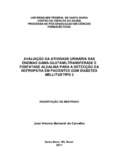| dc.creator | Carvalho, José Antonio Mainardi de | |
| dc.date.accessioned | 2011-12-07 | |
| dc.date.available | 2011-12-07 | |
| dc.date.issued | 2011-06-17 | |
| dc.identifier.citation | CARVALHO, José Antonio Mainardi de. Assessment of urinary gamma-glutamyltransferase and alkaline phosphatase activities for diagnosis of nephropathy in patients with type 2 diabetes. 2011. 74 f. Dissertação (Mestrado em Farmacologia) - Universidade Federal de Santa Maria, Santa Maria, 2011. | por |
| dc.identifier.uri | http://repositorio.ufsm.br/handle/1/5903 | |
| dc.description.abstract | Background: Diabetic nephropathy (DN) is defined as a rise in urinary albumin excretion rate, often associated with an increase in blood pressure. It is the leading cause of end-stage renal disease and carries an increased risk for cardiovascular mortality. Microalbuminuria is the first sign of diabetic renal impairment or incipient nephropathy and is generally considered the best noninvasive predictor for the development of DN. Urinary markers of tubular damage are mainly composed of enzymes or plasma proteins of low molecular weight that are normally freely filtered by the glomerulus, and these biomarkers can be useful for diagnosis of DN. Thus, the aim of this study was to test the diagnostic accuracy of the urinary excretion of gama-glutamyltransferase (GGT) and alkaline phosphatase (ALP) for diagnosis of diabetic nephropathy (DN).
Methods: Fasting glucose, fructosamine, serum creatinine, glomerular filtration rate (GFR), serum uric acid, serum albumin, and urinary albumin, creatinine, GGT and ALP were assessed in 74 type 2 diabetic patients without nephropathy and 38 type 2 diabetic patients with nephropathy.
Results: Urinary GGT and ALP were threefold higher in type 2 diabetic patients with nephropathy. Significant correlations were observed between urinary albumin and GGT (r=0.439, P<0.001) and urinary albumin and ALP (r=0.305, P<0.01). Areas under the curve for GGT and ALP were 0.7696 (P<0.001) and 0.7233 (P<0.001), respectively. At a cut-off value of 72 U/g creatinine, GGT demonstrated a sensitivity of 96.0% and a specificity of 52.6%. At a cut-off value of 20 U/g creatinine, ALP demonstrated a sensitivity and specificity of 83.8% and 36.8%, respectively.
Conclusions: Urinary GGT and ALP have potential value in the diagnosis of nephropathy in type 2 diabetic patients, but GGT has a slightly higher ability to discriminate nephropathy than ALP. | eng |
| dc.format | application/pdf | por |
| dc.language | por | por |
| dc.publisher | Universidade Federal de Santa Maria | por |
| dc.rights | Acesso Aberto | por |
| dc.subject | Albuminúria | por |
| dc.subject | Fosfatase alcalina | por |
| dc.subject | Nefropatia diabética | por |
| dc.subject | Gama-glutamiltransferase | por |
| dc.subject | Alkaline phosphatase | eng |
| dc.subject | Diabetic nephropathy | eng |
| dc.subject | Gamma glutamyltransferase | eng |
| dc.title | Avaliação da atividade urinária das enzimas gama-glutamiltransferase e fosfatase alcalina para a detecção da nefropatia em pacientes com diabetes Mellitus tipo 2 | por |
| dc.title.alternative | Assessment of urinary gamma-glutamyltransferase and alkaline phosphatase activities for diagnosis of nephropathy in patients with type 2 diabetes | eng |
| dc.type | Dissertação | por |
| dc.description.resumo | Introdução: A nefropatia diabética (ND) é definida como um aumento na taxa de excreção urinária de albumina, sendo esta frequentemente associada ao aumento da pressão sanguínea. A ND é a principal causa de doença renal em estágio final, estando também associada ao aumento do risco de mortalidade cardiovascular. A microalbuminúria é o primeiro sinal de dano renal ou nefropatia incipiente, sendo geralmente considerado o melhor preditor não-invasivo para o desenvolvimento de ND. Os marcadores urinários de dano tubular são principalmente compostos por enzimas ou proteínas plasmáticas de baixo peso molecular que são normalmente filtradas pelo glomérulo, sendo que estes biomarcadores podem ser úteis para o diagnóstico da ND. Assim, o objetivo deste estudo foi avaliar as características diagnósticas dos níveis urinários de gama-glutamiltransferase (GGT) e fosfatase alcalina (FAL) para o diagnóstico da ND.
Métodos: Glicemia de jejum, frutosamina, creatinina sérica, taxa de filtração glomerular (TFG), ácido úrico, albumina, além dos níveis urinários de albumina, GGT e FAL foram mensurados em 74 pacientes diabéticos tipo 2 sem nefropatia e 38 pacientes diabéticos tipo 2 com nefropatia.
Resultados: As enzimas GGT e FAL, mensuradas em amostras de urina, foram três vezes mais elevadas nos pacientes diabéticos tipo 2 com nefropatia. Foram observadas correlações significativas entre a albumina urinária e GGT (r=0,439, P<0,001) e albumina urinária e FAL (r=0,305, P<0,01). As áreas sob a curva para GGT e FAL foram 0,7696 (P<0,001) e 0,7233 (P<0,001), respectivamente. Ao considerar o ponto de corte de 72 U/g de creatinina, a GGT demonstrou uma sensibilidade de 96,0% e especificidade de 52,6%. Considerando o ponto de corte de 20 U/g de creatinina, a FAL demonstrou uma sensibilidade e especificidade de 83,8% e 36,8%, respectivamente.
Conclusões: As enzimas GGT e FAL mensuradas em amostras de urina apresentaram potencial valor para o diagnóstico de nefropatia em pacientes com diabetes tipo 2, mas a GGT apresentou uma habilidade discretamente superior à FAL nesta diferenciação. | por |
| dc.contributor.advisor1 | Moresco, Rafael Noal | |
| dc.contributor.advisor1Lattes | http://lattes.cnpq.br/2269922709577261 | por |
| dc.contributor.referee1 | Weinmann, Angela Regina Maciel | |
| dc.contributor.referee1Lattes | http://lattes.cnpq.br/9151119377173425 | por |
| dc.contributor.referee2 | Machado, Michel Mansur | |
| dc.contributor.referee2Lattes | http://lattes.cnpq.br/7651341120825287 | por |
| dc.creator.Lattes | http://lattes.cnpq.br/7496528612964234 | por |
| dc.publisher.country | BR | por |
| dc.publisher.department | Análises Clínicas e Toxicológicas | por |
| dc.publisher.initials | UFSM | por |
| dc.publisher.program | Programa de Pós-Graduação em Ciências Farmacêuticas | por |
| dc.subject.cnpq | CNPQ::CIENCIAS DA SAUDE::FARMACIA | por |


